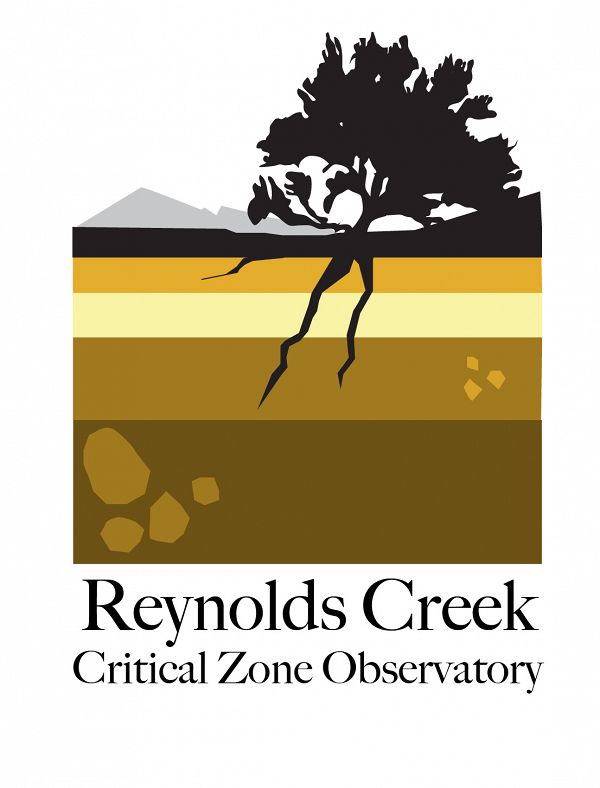Summary & Purpose
Soil physical and hydrologic properties were determined on soils ranging from 1425 to 2111 m elevation within the Reynolds Creek Critical Zone Observatory (CZO). Climate varied between elevations, with mean annual precipitation (MAP) from 292 to 800 mm, respectively, and mean annual temperature (MAT) from 9.4 to 5.6 °C. Vegetation was dominated by various sub-species of sagebrush at all sites. Lithology was derived from basalt and Rhyolitic welded tuff at all sites except Johnston Draw, which was derived from granitic parent material. Soils were collected from profiles by genetic horizons down to ~1 m or bedrock. Soil hydraulic properties were determined in the lab using a dew point potentiometer to determine the drier end of the soil water characteristic curves. Estimates of soil water retention and hydraulic conductivity near saturation were determined using a multistep-outflow and evaporation method. Soil bulk densities were also determined, and soil particle size distributions were previously determined (Patton et al. 2017). Using Marquardt-Levenberg type parameter optimization, soil hydraulic parameters for the standard van Genuchten-Mualem water retention and hydraulic conductivity functions were inversely fit. For several rocky subsoils where intact soil cores could not be collected, hydraulic parameters were estimated using a pedotransfer function (RosettaLite v1.1), bracketed using measurements from the nearest soil horizons. Results display subtle increases in soil water storage capacity (1.06%) and effective saturated hydraulic conductivity (~10%) moving from low to high elevations in the watershed. Both alpha (1.9%) and n (1.1%) parameters increased with increasing elevation and rainfall, typical of coarsening soils. In contrast, however, soil particle size distributions had more silt+clay fraction at the highest elevation site. Soil Bulk density was lowest at the high elevation site. Plant available water, determined from weighted average values of field saturated volumentric water content and the water content at the permanent wilting point displayed no trend with elevation or precipitation, suggesting potential tradeoffs in controls on ecohydrological processes with elevation. Not surprising, plant available water was highest in under-shrub soils vs. bare inter-plant patch spaces. In addition, the saturated water holding capacity was greater in surface soils at the low elevation site, with low precipitation, but greater in subsoil horizons at higher elevations with greater precipitation, presumably due to greater eluviation with greater precipitation totals.
Date of Publication or Submission
5-1-2018
DOI
https://doi.org/10.18122/reynoldscreek/10/boisestate
Funding Citation
This study was conducted at the USDA Agriculture Research Service, Northwest Watershed Research Center, Boise, Idaho, USA. Sample collection was facilitated by USDA-ARS, private landowners within the Reynolds Creek Critical Zone Observatory (RC CZO), and the Reynolds Creek CZO itself. Support for this research was provided by USDA-ARS and the NSF for RC CZO Cooperative agreement NSF EAR-1331872(Kathleen Lohse, Principal Investigator; Nancy Glenn, Co-Principal Investigator; Alejandro Flores, Co-Principal Investigator; Shawn Benner, Co-Principal Investigator; Mark Seyfried, Co-Principal Investigator). Data are available at the criticalzone.org data portal. The authors declare no financial conflicts.
Data Source Credits
USDA soil texture classifications, https://www.nrcs.usda.gov/wps/portal/nrcs/detail/soils/survey/?cid=nrcs142p2_054167. Patton et al. (2017), https://doi.org/10.18122/B2612K. Dataset for Soil Properties of Reynolds Mountain East a Subcatchment of Reynolds Creek, Idaho Patton et al. (2018), https://doi.org/10.18122/B29T3T
Single Dataset or Series?
Single Dataset
Map Area
4794475, 4767290
Map Area
526999, 510185
Time Period
Jan. 2014-April 2018
Privacy and Confidentiality Statement
Boise State is explicitly compliant with federal and state laws surrounding data privacy including the protection of personal financial information through the Gramm-Leach-Bliley Act, personal medical information through HIPAA, HITECH and other regulations. All human subject data (e.g., surveys) has been collected and managed only by personnel with adequate human subject protection certification.
Use Restrictions
1. Use our data freely. All CZO, USGS, and USDA-ARS Data Products* except those labelled Private** are released to the public and may be freely copied, distributed, edited, remixed, and built upon under the condition that you give acknowledgement as described below. 2. Give proper acknowledgement. Publications, models and data products that make use of these datasets must include proper acknowledgement, including citing datasets in a similar way to citing a journal article (i.e. author, title, year of publication, name of CZO “publisher”, edition or version, and URL or DOI access information. See http://www.datacite.org/whycitedata). 3. Let us know how you will use the data. The dataset creators would appreciate hearing of any plans to use the dataset. Consider consultation or collaboration with dataset creators. *CZO Data Products. Defined as a data collected with any monetary or logistical support from a CZO.
Disclaimer of Warranty
BOISE STATE UNIVERSITY MAKES NO REPRESENTATIONS ABOUT THE SUITABILITY OF THE INFORMATION CONTAINED IN OR PROVIDED AS PART OF THE SYSTEM FOR ANY PURPOSE. ALL SUCH INFORMATION IS PROVIDED "AS IS" WITHOUT WARRANTY OF ANY KIND. BOISE STATE UNIVERSITY HEREBY DISCLAIMS ALL WARRANTIES AND CONDITIONS WITH REGARD TO THIS INFORMATION, INCLUDING ALL WARRANTIES AND CONDITIONS OF MERCHANTABILITY, WHETHER EXPRESS, IMPLIED OR STATUTORY, FITNESS FOR A PARTICULAR PURPOSE, TITLE AND NON-INFRINGEMENT. IN NO EVENT SHALL BOISE STATE UNIVERSITY BE LIABLE FOR ANY SPECIAL, INDIRECT OR CONSEQUENTIAL DAMAGES OR ANY DAMAGES WHATSOEVER RESULTING FROM LOSS OF USE, DATA OR PROFITS, WHETHER IN AN ACTION OF CONTRACT, NEGLIGENCE OR OTHER TORTIOUS ACTION, ARISING OUT OF OR IN CONNECTION WITH THE USE OR PERFORMANCE OF INFORMATION AVAILABLE FROM THE SYSTEM. THE INFORMATION PROVIDED BY THE SYSTEM COULD INCLUDE TECHNICAL INACCURACIES OR TYPOGRAPHICAL ERRORS. CHANGES ARE PERIODICALLY ADDED TO THE INFORMATION HEREIN. COMPANY AND/OR ITS RESPECTIVE SUPPLIERS MAY MAKE IMPROVEMENTS AND/OR CHANGES IN THE PRODUCT(S) AND/OR THE PROGRAM(S) DESCRIBED HEREIN AT ANY TIME, WITH OR WITHOUT NOTICE TO YOU. BOISE STATE UNIVERSITY DOES NOT MAKE ANY ASSURANCES WITH REGARD TO THE ACCURACY OF THE RESULTS OR OUTPUT THAT DERIVES FROM USE OF THE SYSTEM.
Recommended Citation
Murdock, Mark D.; Huber, David P.; Seyfried, Mark S.; Patton, Nicholas R.; and Lohse, Kathleen A.. (2018). Dataset for Soil Hydraulic Parameter Estimates Along an Elevation Gradient in Dryland Soils [Data set]. Retrieved from https://doi.org/10.18122/reynoldscreek/10/boisestate

